The BEST All-Purpose Stir Fry Sauce Recipe (Easy!)
This super easy 5-minute Chinese Stir Fry Sauce Recipe perfectly complements any stir-fried meat and veggies. A delicious, budget-friendly, homemade sauce made with simple ingredients and steps. It’s so good you’ll never buy store-bought or takeout versions again!
Table of Contents
Why You’ll Love This Recipe!
Allow me to introduce you to the BEST, easy Stir Fry Sauce Recipe! I love this sauce because it tastes as good (or better!) than a Chinese restaurant, but is super simple. Just add the ingredients to a mason jar, shake, or whisk, and serve! Homemade sauces are always a hit around here because they’re so easy to customize!
This sauce pairs perfectly with all stir fries- Any beef, shrimp, tofu, pork, chicken breast, chicken thighs, or vegetable stir-fry dish. Serve with white rice, or use my cauliflower rice hack for a low-carb option.
My favorite thing about making stir-fries is that I use whatever fresh produce and protein I have on hand. I typically make it once a week in order to clean out my produce drawer and use up meat I’ve defrosted. It takes less than 30 minutes to make a complete meal of vegetables and protein and this delicious, addicting sauce!
Recipe Highlights
- Budget-Friendly: This recipe tastes better than takeout and store-bought sauce and is much less expensive!
- Easy Recipe: Making your own Chinese stir fry sauce recipe is easy and healthier than alternatives, but it still tastes like a high-quality meal! Perfect for busy weeknights.
- Flavorful: Savory, sweet, and tangy flavors like soy sauce, sesame oil, rice vinegar, ginger, and garlic are all whisked together, bursting with flavor—all the things you love about Asian-inspired recipes in one lovely sauce.
- Easy Swaps & Variations: Adjust this recipe to be vegan or gluten-free, spicy or mild, soy-free, and more.
Watch The Recipe Video
Note: You can also watch this recipe video on YouTube.
Ingredient Notes
Just 8 simple ingredients (mostly pantry staples!) and 1 step. It’s that easy! It’s a for-everyone kind of sauce, and in my house, that’s the BEST.
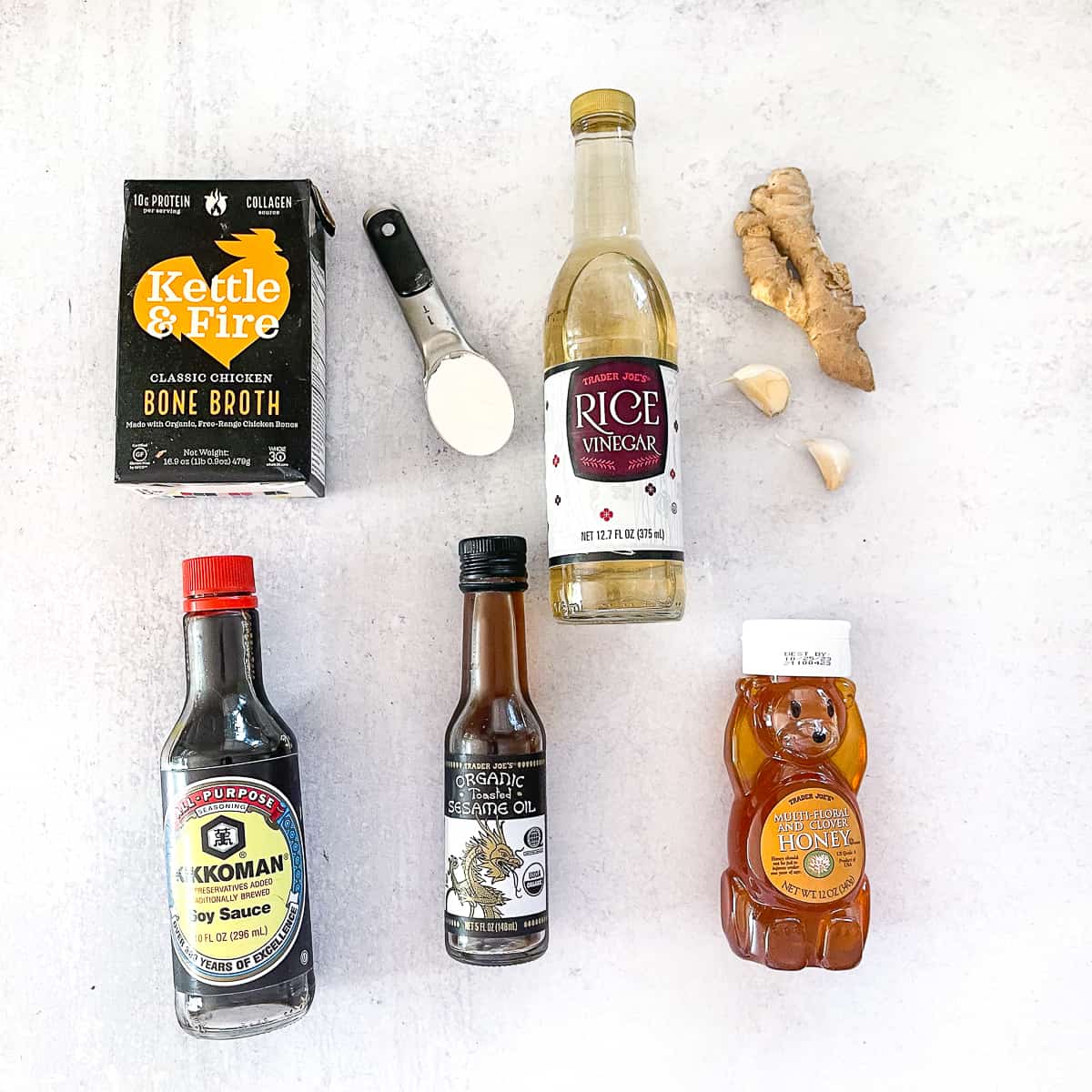
- Soy Sauce: Use low-sodium soy sauce because regular soy sauce is very salty. If you’re looking for a gluten-free soy sauce alternative, try Tamari (you seriously can’t tell the difference!). If you’re soy-free, use coconut aminos.
- Chicken Stock (or Chicken Broth): I use Kettle + Fire organic chicken bone broth (my favorite! Use code TASTESLOVELY for 20% off!). You can use chicken, beef, or veggie broth/stock. You can also use water if that’s all you have on hand. If you’re vegan, use vegetable broth.
- Cornstarch: In place of corn starch, you can use all-purpose flour, arrowroot starch, or tapioca flour (which is gluten-free!).
- Honey: Instead of brown sugar, I use honey. You can also use pure maple syrup, coconut sugar, or agave nectar if you want a vegan alternative. You can also use brown sugar if you prefer, but I like using natural sweeteners. It’s really up to you!
- Sesame Oil: This adds richness and depth that is so delicious.
- Rice Vinegar: This is where the sweet, tangy flavor comes from, and I personally love it. It’s a very mild vinegar, so it won’t overwhelm the sauce. You can also use white vinegar in a pinch.
- Fresh Ginger & Garlic: I like to use fresh ginger and mince fresh garlic cloves. It adds such a strong, delicious flavor. In a pinch, you can also use powdered ginger and garlic powder.
Check out the recipe card below for the complete list of ingredients and amounts.
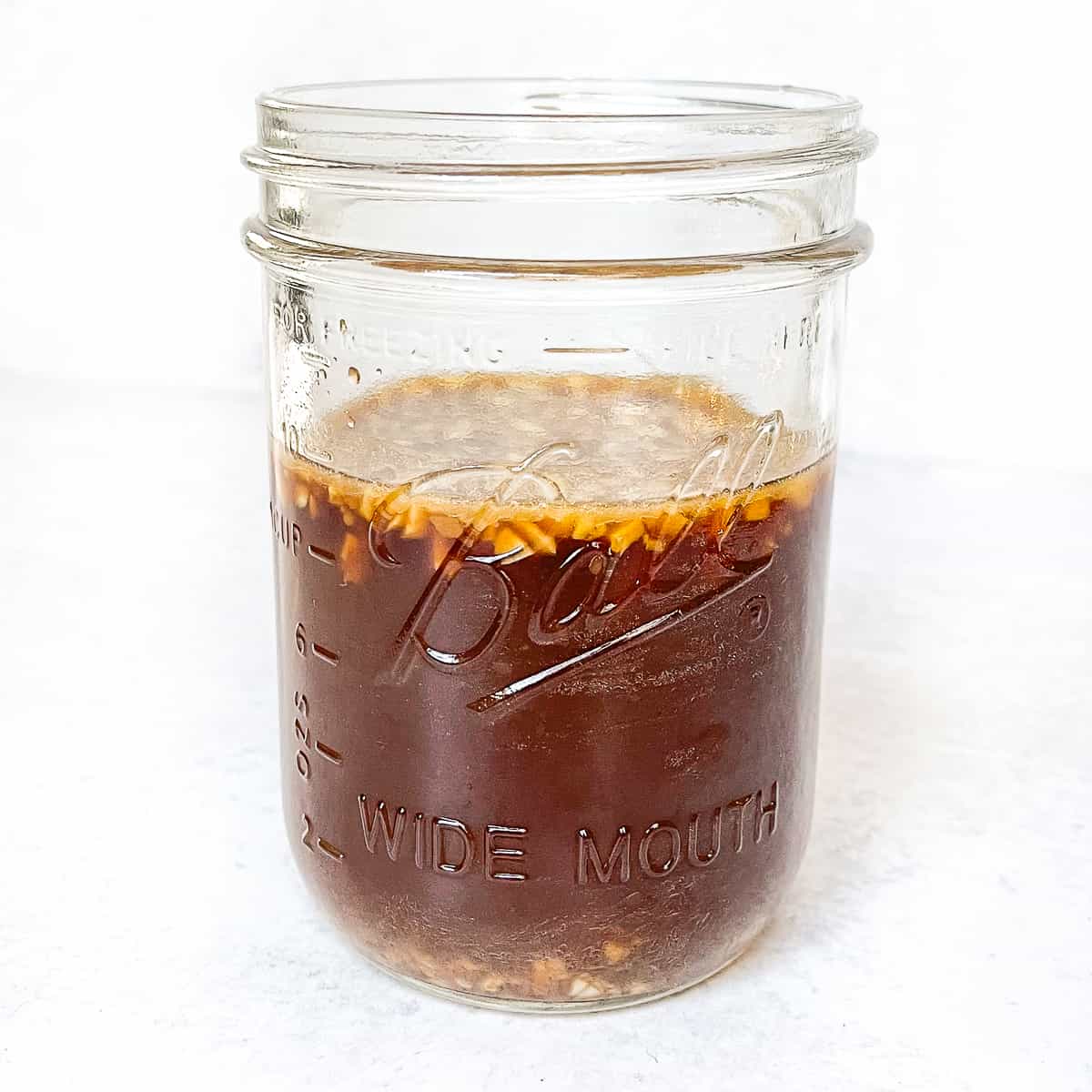
How to Make Stir Fry Sauce in 5 Minutes!
Step 1: Combine all the ingredients in a small bowl or mason jar, and whisk or shake until combined.
Step 2: Store for later use or add to your stir-fried protein and veggies (instructions below!).
Expert Tips & Recipe Variations
- When you add this sauce to your stir-fried veggies and protein, add the sauce last. Cook the sauce for 3 minutes over medium-high heat to allow the thickening agent to thicken.
- If you need a larger yield, click on the printable recipe in the recipe card below and adjust the number of servings. Changing the number of servings will adjust the ingredient amounts.
- Vegan: If you are vegan, use vegetable broth and agave nectar or pure maple syrup.
- Spice it Up: If you prefer a spicier sauce, add red pepper flakes (to taste). As written, this sauce is very mild.
- Keto/Low-Carb: If you are low-carb, use tapioca flour or arrowroot instead of cornstarch and monk fruit sweetener. Or click here for my Keto Stir-Fry Sauce recipe!
- Gluten-Free: While it seems like soy sauce is gluten-free, it’s not. If you’re gluten-free, use Tamari instead of soy sauce.
- Low-Sodium: I always use low-sodium soy sauce because the saltiness of regular soy sauce is overpowering. If you’re the same or need less salt for dietary reasons, use a low-sodium soy sauce or swap for coconut aminos.
How to Make a Simple Stir Fry Dinner!
Use this to make an easy beef stir fry or chicken stir fry (or vegetable stir fry with no meat) that serves 4, or check out my other homemade stir fry recipes for a fun variety of options. You can use whatever meat and veggies you have on hand. So clean out your produce drawer and enjoy!

- Heat a large skillet over medium-high heat. Add in 2 tablespoons oil, then 1 pound of protein of your choice, cubed.
- Cook for 5-7 minutes, stirring occasionally, until the protein is cooked through. Transfer the protein to a plate.
- Add another 2 tablespoons of oil and 4 cups of chopped vegetables of your choice in the same skillet. (broccoli, green beans, bell peppers, asparagus, snow peas, bean sprouts, onion, mushrooms, carrots, snap peas, bok choy, zucchini, etc.). Cook for 5-7 minutes until the veggies are crisp-tender.
- Add the protein back to the pan, and pour over all 1-1/4 cups of the sauce. Allow coming to a bubble, which will activate the thickener.
- Remove from the heat and serve with warm cooked rice, cauliflower rice, or noodles.
Serving Tips
- This recipe yields 1-1/4 cups of sauce. This is the perfect amount for an easy beef or chicken stir fry that serves 4 for dinner or a great meal prep option.
- Smother your stir-fried meats and veggies with this sauce and serve warm over white or brown rice or cauliflower rice for a low-carb option. You can even serve it with your favorite Asian noodles. Customize it to your liking!
Storage Tips
- Leftovers: Store leftovers in an airtight container or mason jar with a lid in the refrigerator for up to 1 week, though you will probably eat them sooner!
- Freezing: If you have leftovers, you can freeze them! Freeze in any freezer-safe container for up to 6 months. Thaw overnight in the refrigerator, then reheat it over the stovetop to use for any Asian-inspired recipe.
Recipe FAQs
Yes! You can use my swaps above to make this recipe even healthier and lifestyle-friendly. It’s super versatile and tastes amazing in all the different ways you make it. Depending on your needs, if I’ve missed something here, please ask me in the comments, and I’d be happy to help you figure out swaps that work for your diet and lifestyle.
This recipe yields 1-1/4 cups of sauce, which is the perfect serving size for a stir fry recipe that serves 4 people. If you want more sauce, the printable recipe card below easily adjusts by increasing the number of servings you need.
You can use cornstarch, Tapioca Flour, or Arrowroot powder. If your sauce is too thin, add an additional 1 tsp at a time and stir for one minute. Continue to add until desired thickness is reached.
If you use vegetable broth, maple syrup, or agave instead of honey, yes! If you are a vegetarian but not vegan, you can use honey.
If you are soy-free, swap the soy sauce for liquid aminos or coconut aminos. You will achieve the same great flavor, without any soy.
Yes! Use low-sodium soy sauce, and low-sodium or “no salt added” broth or stock.

The BEST All-Purpose Stir Fry Sauce Recipe (Easy!)
Ingredients
- 1/2 cup low sodium soy sauce*, *Use Low-Sodium soy sauce as the saltiness of regular may be overpowering.
- 1/2 cup Kettle + Fire chicken stock bone broth
- 2 tablespoons fresh chopped ginger
- 2 cloves garlic, grated or finely minced
- 1 tablespoon corn starch
- 1 tablespoon honey
- 1 teaspoon sesame seed oil
- 1 teaspoon rice vinegar
Instructions
Stir Fry Sauce
- Combine all ingredients in a bowl or mason jar, and whisk or shake until combined.
- Makes 1-1/4 cups. You can use immediately, or keep refrigerated in an airtight container for 1 week.
How To Make A Stir Fry
- Heat a large skillet over medium-high heat. Add in 2 tablespoons oil, then 1 pound of protein of your choice, cubed.
- Cook for 5-7 minutes, stirring occasionally until the protein is cooked through. Transfer the protein to a plate.
- In the same skillet, add another 2 tablespoons of oil and 4 cups of chopped vegetables of your choice. (broccoli, green beans, bell pepper, asparagus, onion, mushrooms, zucchini, etc). Cook for 5-7 minutes until the veggies are crisp-tender.
- Add back in the protein, and pour over all 1-1/4 cups of the sauce. Allow coming to a bubble, which will activate the thickener.
- Remove from the heat and serve with warm cooked rice, cauliflower rice, or noodles.
Notes
Expert Tips/Recipe Variations
-
- USE LOW SODIUM SOY SAUCE! Using regular soy sauce can be too salty for some people.
- When you add this sauce to your stir-fried veggies and protein, add the sauce last. Cook the sauce for 3 minutes over medium-high heat to allow the thickening agent to thicken.
-
- If you need a larger yield, click on the printable recipe in the recipe card below and adjust the number of servings. Changing the number of servings will adjust the ingredient amounts.
-
- Vegan: If you are vegan, use vegetable broth and agave nectar or pure maple syrup.
-
- Spice it Up: If you prefer a spicier sauce, add red pepper flakes (to taste). As written, this sauce is very mild.
-
- Keto/Low-Carb: If you are low-carb, use tapioca flour or arrowroot instead of cornstarch and monk fruit sweetener. Or click here for my Keto Stir-Fry Sauce recipe!
-
- Gluten-Free: While it seems like soy sauce is gluten-free, it’s not. If you’re gluten-free, use Tamari instead of soy sauce.
- Low-Sodium: I always use low-sodium soy sauce because the saltiness of regular soy sauce is overpowering. If you’re the same or need less salt for dietary reasons, use a low-sodium soy sauce or swap for coconut aminos.
Substitutions
- Soy Sauce: If you are soy-free, you can substitute liquid aminos or coconut aminos in the same quantities. If you are looking for a gluten-free option, try Tamari.
- Chicken Stock: You can use chicken, beef, or veggie broth/stock. You can also use water if that’s all you have on hand.
- Fresh Ginger: In place of fresh ginger, use 2 teaspoons of powdered ginger.
- Cornstarch: In place of cornstarch, you can use all-purpose flour or tapioca flour (which is gluten-free!). Same quantity for all substitutions.
- Honey: In place of honey you can use maple syrup, agave nectar, white sugar, brown sugar, or coconut sugar. Same quantity for all substitutions.
- Rice Vinegar: In place of rice vinegar you can use white vinegar.
Serving Tips
-
- This recipe yields 1-1/4 cups of sauce. This is the perfect amount for an easy beef or chicken stir fry that serves 4 for dinner or a great meal prep option.
-
- Smother your stir-fried meats and veggies with this sauce and serve warm over white or brown rice or cauliflower rice for a low-carb option. You can even serve it with your favorite Asian noodles. Customize it to your liking!
Storage Tips
-
- Leftovers: Store leftovers in an airtight container or mason jar with a lid in the refrigerator for up to 1 week, though you will probably eat them sooner!
-
- Freezing: If you have leftovers, you can freeze them! Freeze in any freezer-safe container for up to 6 months. Thaw overnight in the refrigerator, then reheat it over the stovetop to use for any Asian-inspired recipe.


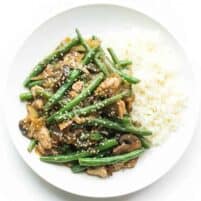
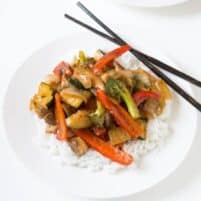


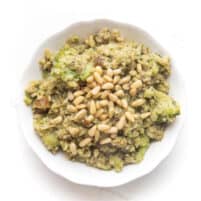

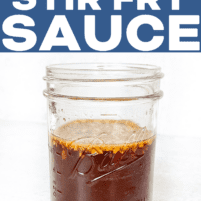
615 Comments on “The BEST All-Purpose Stir Fry Sauce Recipe (Easy!)”
Easy and delicious!! This will be a regular for us. I used powdered ginger and forgot the broth, but it was still yummy and we had only two people so the amount wasn’t off.
Thank you, Mary!
Love how easy this was!
Thank you, Carrie!
Well. I have tried a lot of stir-fry sauce recipes, and this was, in fact, the best. I added some jarred minced chilies because I wanted a bit of spice, but otherwise followed the recipe. It was perfect: great consistency, nice glossy appearance, and excellent flavor. And it was just as easy as advertised.
Thank you, Rebecca! This is such a great compliment on one of my favorite recipes! So so glad you enjoyed it!
Delicous but I only had regular soy sauce and it was way too salty. Next time I’ll use less soy and more water. Also looking forward to trying some additional spice and ingredient variations. Thank you for this :-)
Thanks, John! Looking forward to hearing how it turns out next time!
So yummy! Next time, I’ll use fresh ginger and garlic, even though it was delicious with powdered ginger and jarred minced garlic! No more store bought for me. Don’t forget the pepper flakes, (I used Domino’s packet that I had on hand.)
So glad you liked it! Can’t wait to hear what you think next time with the fresh garlic and ginger!
Was easy to make and was really delicious! Definitely will make again!
Thank you! So glad you liked it!
I followed the directions to the letter. Not much flavor, to be honest. Won’t use this recipe again.
So sorry to hear this. I hope you find one you love!
Hey!
You have several really good recipes, but I’v been looking for a sauce to put over pasta, an Asian sauce that is sweet, sour and a little hot. Some sauce that is easy to make. Any ideas?
Thanks,
Larry-Mobile, AL
The sauce I use in my Asian Beef + Vegetable Noodle Stir Fry would be perfect! Has a little bit of a kick from the sriracha. You’ll love it!
I liked it!
Thank you, Cheryl!
Oh magically delicious! I added a tablespoon of Sriracha sauce and bam, fantastic, thank you for this recipe
Oh yay! This makes me so happy! Thank you, Jer!
It’s me again!! The last time I commented was September 21, 2021. I made this again tonight as a sauce for lo mein. I told my husband that my lo mein can stand against any Chinese restaurant — all because of your BEST stir fry sauce. Everyone who reads this post should know that THERE IS NO BETTER STIR FRY SAUCE OUT THERE!!!!! I use this all the time. I only make one alteration. For health reasons, my husband is severely salt restricted. I found a teriyaki sauce that is literally 49% less than even low salt soy sauce, so I use that. Otherwise, it’s all you!!! Thank you again for sharing,
You are the sweetest! Thank you so much! This is such a huge compliment and means the world to me! Even better, you’ve found a way to tweak it to work for you and your husband! Love love love!
I have tried many different stir fry sauce recipes and this is hands down the best one out there! I make it once a week! So good!!
Thank you, Kathryn! This means so much to me!
Easily the best stir fry I have ever made! I only had a third of cup of soy so I made up the difference with chicken broth. I think I will continue to do it this way as we both absolutely loved it! Thank u so much for sharing. It has become a stir-fry game-changer for me! I used beef coated in cornstarch which is my favorite protein and added yaki-soba noodles when I returned the beef to the pan. Simply awesome!
You are so sweet, Jill! Thank you! I am so glad you liked this recipe and were able to tweak it to your liking! Enjoy!!
this is the best sauce ever,use it on chicken,pork, salmon, love it,
Thank you, Judith! So so glad you like it!
Far too much soy sauce
I’m sorry it was too much for you. I love it with reduced sodium soy sauce so it’s not too much for me!
Yep, the saltiest sauce I have ever tried. (I used regular soy sauce.) I’m a bit shocked that so many people like it.
The flavor is okay what I can taste through the salt. I followed the recipe exactly using low sodium soy sauce and it’s still far too salty for my tastes.
Oh darn! I’m sorry it’s too salty for you. I appreciate the feedback!
Hi Zach- so sorry to hear this. I recommend using low-sodium soy sauce for this issue. Thanks!
Fantastic sauce! I added 1 TBL Shiracha hot sauce. Love it and making Pork stir fry tonight and will make more for a great Black bean salad!
Thank you!
Juli
Thank you Juli! I bet the sriracha added a wonderful kick! I am so glad you loved this recipe.
Very easy to make and taste delicious. I did add a little bit more honey to my mix.
Thank you, Stephanie! So glad you liked it!
Absolutely love this sauce! It’s now my go to for stir fry.
Love to hear this! Thanks, Juanita!
Easy and so good. This recipe is on constant rotation for us – I have probably used it close to 100 times by now and shared it with friends. Always great to find a recipe that’s so good and also simple.
Thank you, Amie! I am so honored that you have made this recipe so many times and share it so often! Means SO much to me!
Found it. Made it. Loved it. Will be our new “go to” for home cooked stir fry. Also appreciated options for substitutions.
Yea! This totally made my day! Thank you, Ann! So honored for this recipe to be your new “go-to”- the best compliment!